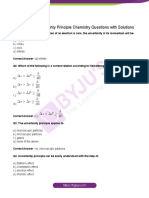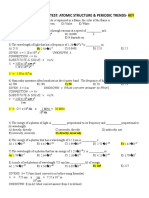AP Unit 1 Question Bank
AP Unit 1 Question Bank
Uploaded by
Buy OnlineCopyright:
Available Formats
AP Unit 1 Question Bank
AP Unit 1 Question Bank
Uploaded by
Buy OnlineCopyright
Available Formats
Share this document
Did you find this document useful?
Is this content inappropriate?
Copyright:
Available Formats
AP Unit 1 Question Bank
AP Unit 1 Question Bank
Uploaded by
Buy OnlineCopyright:
Available Formats
MALLA REDDY UNIVERSITY
Applied Physics (AP)
Unit-1
LASER AND FIBER OPTICS
LASERS
1. What do you understand by LASER?
Answer: The word LASER stands for Light Amplification by Stimulated Emission of
Radiation. It is a device which is used to produce monochromatic, collimated,
unidirectional, intense and highly coherent beam of light with small divergence.
2. What is the principle of laser?
Answer: The principle of laser depends on the phenomenon of stimulated emission
3. What is the principle of laser?
Answer: The principle of laser depends on the phenomenon of stimulated emission
4. What is absorption of radiation?
Answer: Absorption is the process of raising the atom to its excited state by which a
photon is absorbed by the atom.
5. What do you understand by spontaneous emission?
Answer: When an atom in its excited state energy state E2 makes a transition to its
ground state E1 by emitting a photon of energy E2 - E1 without any outside influence,
then it is known as spontaneous emission of radiation.
6. Why is spontaneous emission incoherent?
Answer: Spontaneous emission is incoherent because during spontaneous emission
radiation is a random mixture of quanta with various wavelengths. This is why waves
neither coincide in wavelength nor in phase.
7. What is stimulated emission?
Answer: Stimulated emission is the process by which an atom is induced with photon
to make transition from higher energy level to lower energy level by emitting an
additional photon of same energy.
8. What is population inversion?
Answer: To increase the probability of stimulated emission, the number of atoms in
higher energy state (N2) must be made greater than the number of atoms in lower
energy state (N1). This is called population inversion.
9. What is pumping?
Answer: The process by which we can raise atoms from lower energy state to higher
energy state is known as pumping.
Short Answer Type Questions
1. What is a LASER? Who invented the first laser and when?
2. Name the characteristics of laser light.
3. Explain spatial and temporal coherence with suitable diagram.
4. What is pumping?
5. Give the name of different types of pumping.
6. What are the differences between ordinary light and monochromatic light?
7. What is active medium?
8. Why it is easier to achieve the lasing action in a four-level system compared to a three-
level system?
9. Why is He–Ne laser superior to Ruby laser?
10. Give some examples of laser
Long Answer Type Questions
1. What do you mean by LASER? Explain spontaneous and stimulated emission of
radiations.
2. What is the principle of laser? Explain the characteristics which differentiate and
make laser light useful compared to normal light.
3. What do you understand by pumping? Explain various types of pumping with
suitable examples.
4. Explain the basic components of laser system
FIBER OPTICS
1. What do you understand by fiber optics?
Answer: Fiber optics is made of glass or plastic pipes as thin as human hair, through
which light can be propagated. It consists of essentially three regions. The innermost
region is known as core. It is made of glass or plastic. The middle region which covers
the core with another layer of glass or plastic is called the cladding. The outermost region
is called jacket. It is also made of plastic or polymers.
2. What is the principle of fiber optics?
Answer: Fiber optics is based on the principle of total internal reflection (TIR) so that
optical signal can travel long distances with negligible loss.
3. Give the necessary conditions for total internal reflection.
Answer: The necessary conditions for total internal reflection are as follows:
• Light wave should be propagated from denser medium to rarer.
• The angle of incident should be greater than critical angle
4. What is acceptance angle and numerical aperture?
Answer: The maximum angle at which light entering the core is transmitted through the
fiber and propagated without being refracted is known as acceptance angle. The sine of
acceptance angle is known as numerical aperture
5. How is light transmitted through fiber optics?
Answer: When the light signal is incident on the core and makes an angle of incidence
greater than the critical angle of the core- cladding surface, multiple total internal
reflection phenomena occurs. In this way, light signals can be propagated or transmitted
through the fiber.
6. What do you understand by modes of propagation?
Answer: When light ray travels along different ray paths in fiber, these paths are known
as modes of propagation.
Short Answer Type Questions
1. Explain the basic structure of an optical fiber.
2. Why is refractive index of core higher than that of the cladding?
3. What is the use of the cladding in fiber optics?
4. What is step index fiber?
5. What do you mean by mode of propagation?
6. What is the physical significance of V-number?
7. Give the name of different types of optical fiber.
8. What do you understand by dispersion?
9. Distinguish between step index and graded index fiber.
10. Give two applications of optical fiber.
11. What is the principle of optical fiber?
Long Answer Type Questions
1. What is the principle of optical fiber? Explain different types of fiber with suitable diagrams.
2. What do you mean by optical fiber? Explain the propagation mechanism in optical fiber.
3. What is the mode of propagation? Give some examples of fiber optics.
4. Explain acceptance angle, acceptance cone, numerical aperture and critical angle for an
optical fiber.
5. What is the principle of holography? Explain its applications.
6. Describe hexagonal close pack structure.
7. What are the characteristics and applications of laser?
You might also like
- English For NursingDocument16 pagesEnglish For NursingMaria Apostu StylesNo ratings yet
- 235 Wood - 2015 PDFDocument92 pages235 Wood - 2015 PDFEdo Dakedezu100% (2)
- Electrostatics: Electrostatics Jee - Advanced Vol - ViDocument20 pagesElectrostatics: Electrostatics Jee - Advanced Vol - ViArnav Vikas GargNo ratings yet
- Electrode KineticsDocument12 pagesElectrode KineticsSyarif HidayatNo ratings yet
- PMR Spectroscopy: Solved Problems Volume : IIFrom EverandPMR Spectroscopy: Solved Problems Volume : IIRating: 5 out of 5 stars5/5 (3)
- EIM GRADE 9 10 Q4 Module 1b - National Electrical Code NEC Provisions in Installing Wiring Devices - GFCI. - FinalDocument23 pagesEIM GRADE 9 10 Q4 Module 1b - National Electrical Code NEC Provisions in Installing Wiring Devices - GFCI. - FinalTitser Ramca100% (3)
- Level 1 and WOCRM User Guide 2Document7 pagesLevel 1 and WOCRM User Guide 2adityamduttaNo ratings yet
- Compr Solid State Chemistry Questions and AnswersDocument44 pagesCompr Solid State Chemistry Questions and Answersد.حاتممرقهNo ratings yet
- Solid State: Subjective Question For Board ExaminationDocument14 pagesSolid State: Subjective Question For Board ExaminationzohaibsalamNo ratings yet
- Sem-III - Unit - IV (NQR and Epr Spectroscopy)Document46 pagesSem-III - Unit - IV (NQR and Epr Spectroscopy)PG ChemistryNo ratings yet
- Basic Interaction Between X-Rays and MatterDocument62 pagesBasic Interaction Between X-Rays and MatterNazmus SakibNo ratings yet
- Quantum Dot PDFDocument22 pagesQuantum Dot PDFALI ASHRAFNo ratings yet
- Heisenberg Uncertainty Principle QuestionsDocument6 pagesHeisenberg Uncertainty Principle QuestionsPrem MehrotraNo ratings yet
- ATOMIC MODELS AtomicphysicsDocument24 pagesATOMIC MODELS Atomicphysicsahsanbgayo100% (1)
- Doublet Sate of Alkali AtomDocument6 pagesDoublet Sate of Alkali AtomNur IzzatiNo ratings yet
- A Review of Magneto-Optic Effects and Its Application: Taskeya HaiderDocument8 pagesA Review of Magneto-Optic Effects and Its Application: Taskeya HaiderkanchankonwarNo ratings yet
- Half Shade PolarimeterDocument3 pagesHalf Shade PolarimeterAjay Kumar GantiNo ratings yet
- Wiedemann-Franz Law PDFDocument3 pagesWiedemann-Franz Law PDFArunraj KasiNo ratings yet
- Analysis On Conversion Efficiency of Homojunction and Heterojunction Solar Cell Using Semiconductor MaterialsDocument4 pagesAnalysis On Conversion Efficiency of Homojunction and Heterojunction Solar Cell Using Semiconductor MaterialsAnonymous izrFWiQNo ratings yet
- Standard Hydrogen ElectrodeDocument2 pagesStandard Hydrogen ElectrodeAmmara Amy100% (1)
- CBSE Class-12 Physics Quick Revision Notes Chapter-12: AtomsDocument4 pagesCBSE Class-12 Physics Quick Revision Notes Chapter-12: AtomsAshish PalaiNo ratings yet
- D-Block MCQ SolvedDocument12 pagesD-Block MCQ Solved11337pn100% (1)
- The MCQDocument8 pagesThe MCQAboahmed Ali100% (2)
- CH301 Tutorial Solutions On IR Spectros PDFDocument4 pagesCH301 Tutorial Solutions On IR Spectros PDFArjun MaharajNo ratings yet
- M.SC Chemistry Syllabus, DCRUST MurthalDocument96 pagesM.SC Chemistry Syllabus, DCRUST MurthalAnonymous 20dkHAnNo ratings yet
- CHM 101 - Faraday's Laws of ElectrolysisDocument14 pagesCHM 101 - Faraday's Laws of ElectrolysisHaneef Ayinde100% (1)
- Magnetic Properties and ParamagnetismDocument20 pagesMagnetic Properties and Paramagnetismnkar0370% (1)
- Chapter 7 Practice Test AtomStrctrPeriodicTrend GOOD-KEY1Document5 pagesChapter 7 Practice Test AtomStrctrPeriodicTrend GOOD-KEY1Senthereng MoaisiNo ratings yet
- Quantum MechanicsDocument29 pagesQuantum MechanicsHasan ZiauddinNo ratings yet
- Solid StateDocument16 pagesSolid StatePrahasNo ratings yet
- Malayaj - PHY321Assignment No. 4Document8 pagesMalayaj - PHY321Assignment No. 4Malayaj MishraNo ratings yet
- Physics - Question Bank - 3Document8 pagesPhysics - Question Bank - 3Atharv SuryavanshiNo ratings yet
- Abp Quantum Physics Multiple Choice 2009-05-13Document4 pagesAbp Quantum Physics Multiple Choice 2009-05-13ArunmaalaNo ratings yet
- ZN SDocument5 pagesZN SDikshitJain100% (2)
- Irreversible ThermodynamicsDocument2 pagesIrreversible ThermodynamicsManoj PrakashNo ratings yet
- MSC Chem Question BankDocument183 pagesMSC Chem Question BankKundan DeoreNo ratings yet
- M Sc-PhyDocument15 pagesM Sc-Phyamal pvNo ratings yet
- Theoryofirspectroscopy 160622080111Document50 pagesTheoryofirspectroscopy 160622080111ArshNo ratings yet
- MCQ'S in Dual Nature of Matter PDFDocument3 pagesMCQ'S in Dual Nature of Matter PDFMujeeb KhanNo ratings yet
- Unit 4 Semiconductor Physics-Edited PDFDocument57 pagesUnit 4 Semiconductor Physics-Edited PDFMUSICAL MASTI RINGTONENo ratings yet
- Extrinsic SemiconductorsDocument28 pagesExtrinsic SemiconductorsSahil AhujaNo ratings yet
- Superlattice ReflectionsDocument12 pagesSuperlattice ReflectionsVikram ChavanNo ratings yet
- General Properties of Nuclei - IDocument6 pagesGeneral Properties of Nuclei - IAaush PradhanNo ratings yet
- Foster Seeley DiscriminatorDocument2 pagesFoster Seeley DiscriminatorDebesh Bar100% (1)
- Classical AssignmentDocument4 pagesClassical AssignmentbenNo ratings yet
- CHAPTER-chemwiki Mossbauer SpectrosDocument8 pagesCHAPTER-chemwiki Mossbauer SpectrosAparna PrasadNo ratings yet
- Textbook of Physical Chemistry, Second Edition by Moudgil, H. KDocument3 pagesTextbook of Physical Chemistry, Second Edition by Moudgil, H. KAanchal PathakNo ratings yet
- Coordination Compounds Short Answers Type QuestionsDocument5 pagesCoordination Compounds Short Answers Type Questionskrishna kumar bhardwaj100% (1)
- Chapter 3c X Ray DiffractionDocument52 pagesChapter 3c X Ray DiffractionSwarnaRakshit100% (1)
- Multiple Choice Questions For PracticeDocument9 pagesMultiple Choice Questions For PracticeF085-Rohit JaiswalNo ratings yet
- Knoll CH 1 Rad SourcesDocument59 pagesKnoll CH 1 Rad SourcesruqqiNo ratings yet
- L6 Scattering PartialWavesDocument19 pagesL6 Scattering PartialWavesdwyphy100% (1)
- Zeeman and Paschen-Back EffectDocument12 pagesZeeman and Paschen-Back EffectKamanpreet Singh100% (1)
- Short Question Answer of InterferenceDocument3 pagesShort Question Answer of InterferenceRadhika Kadu100% (1)
- ATOMSDocument20 pagesATOMSJanvi ShahiNo ratings yet
- Important Terms: Quantitative AnalysisDocument6 pagesImportant Terms: Quantitative Analysisqasim khokhar100% (1)
- 21CHE12 22 Engineering Chemistry Model Question Paper 2Document3 pages21CHE12 22 Engineering Chemistry Model Question Paper 2Deeksha V PanchalNo ratings yet
- Class:12 Physics Assignment 3 Topic: Dual Nature of Matter and RadiationDocument2 pagesClass:12 Physics Assignment 3 Topic: Dual Nature of Matter and RadiationAkshat RawatNo ratings yet
- Oscillations MCQ Simple Harmonic Motion: Question H1: Why Study This Stuff?Document8 pagesOscillations MCQ Simple Harmonic Motion: Question H1: Why Study This Stuff?hhhhhNo ratings yet
- Solid State Chemistry IPEDocument15 pagesSolid State Chemistry IPEAdiChemAdi100% (4)
- Electricity & ElectromagnetismDocument2 pagesElectricity & ElectromagnetismPrasanth100% (1)
- Domain Theory NotesDocument13 pagesDomain Theory NotesCybertron BadeeNo ratings yet
- UNIT II 2 MarksDocument5 pagesUNIT II 2 MarksMaster SINIVASANNo ratings yet
- Viva Voce - Phy. Exp.Document8 pagesViva Voce - Phy. Exp.p44693749No ratings yet
- Management of Tooth Size Arch Perimeter DiscrepancDocument5 pagesManagement of Tooth Size Arch Perimeter DiscrepancFabio RibeiroNo ratings yet
- GMP Implementation and CCP Determination On ChocolDocument10 pagesGMP Implementation and CCP Determination On ChocolFuji KusumaNo ratings yet
- Saginaw Bay Watershed and Aoc Handout WebDocument12 pagesSaginaw Bay Watershed and Aoc Handout Webapi-234077090No ratings yet
- Chap 3.7 Seagrass EcosystemDocument96 pagesChap 3.7 Seagrass Ecosystemsuganya rameshNo ratings yet
- Islami Qanoon e IrtidadDocument19 pagesIslami Qanoon e IrtidadMuhammad Mustafa RazaNo ratings yet
- Azur 340T User Manual - English PDFDocument12 pagesAzur 340T User Manual - English PDFBaki SineNo ratings yet
- Arrester I235-94Document12 pagesArrester I235-94tableman.test9000No ratings yet
- Experimental Comparison of Chemical Migration From Petrochemical Plastic and Bioplastic Bottles Into Drinking WaterDocument135 pagesExperimental Comparison of Chemical Migration From Petrochemical Plastic and Bioplastic Bottles Into Drinking WaterRichard Copa AliNo ratings yet
- Prescolite Architectural Lighting Catalog G-17 1969Document104 pagesPrescolite Architectural Lighting Catalog G-17 1969Alan MastersNo ratings yet
- 12 - Chemistry QP (Set-I)Document6 pages12 - Chemistry QP (Set-I)Shravan ZoneNo ratings yet
- The Royal Family Copper Silver Gold ReferencesDocument10 pagesThe Royal Family Copper Silver Gold Referenceskrish_cvr2937No ratings yet
- 5 - Pair R. V.Document24 pages5 - Pair R. V.abd syNo ratings yet
- Samsung GT-S8500L Wave 08 Level 3 Repair - Block-, PCB Diagrams, Flow Chart of TroubleshootingDocument38 pagesSamsung GT-S8500L Wave 08 Level 3 Repair - Block-, PCB Diagrams, Flow Chart of TroubleshootingLilianaEsterGuillenNo ratings yet
- A Model of The Dump Leaching Process That IncorporDocument9 pagesA Model of The Dump Leaching Process That IncorporFrancisco CabreraNo ratings yet
- Jvme 30 3 226Document4 pagesJvme 30 3 226Chelwin Glenn Pelaez AsuncionNo ratings yet
- Fig 9. Maximum Safe Operating Area Fig10. Effective Transient Thermal ImpedanceDocument2 pagesFig 9. Maximum Safe Operating Area Fig10. Effective Transient Thermal ImpedanceMarck SolterNo ratings yet
- Algoritma Diagnosis AnemiaDocument2 pagesAlgoritma Diagnosis AnemiaathrahrNo ratings yet
- Comparison of Is BS AciDocument19 pagesComparison of Is BS AciHadjMekkiNo ratings yet
- Materials RequirementDocument17 pagesMaterials RequirementJohny Lou LuzaNo ratings yet
- IntroductionDocument3 pagesIntroductionZahra 9oNo ratings yet
- Pressure in ContainersDocument9 pagesPressure in Containersrocanrol2No ratings yet
- Treatment Planning Assignment - DigmannDocument8 pagesTreatment Planning Assignment - Digmannapi-508053077No ratings yet
- Cement Milling and Separator Closed CircuitDocument35 pagesCement Milling and Separator Closed CircuitmohamedredaNo ratings yet
- Minimum Viable Population Sizes (Shaffer, 1981)Document5 pagesMinimum Viable Population Sizes (Shaffer, 1981)Luan FonsecaNo ratings yet
- Barhorst Cates2018Document24 pagesBarhorst Cates2018486521366987qNo ratings yet
























































































